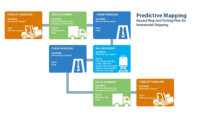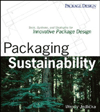Materials Technology: Sustainable Materials
Testing lightweight product packaging in the supply chain
Lightweighting helps reduce carbon footprint.


Through the physical testing in the lab and the derived model, it was determined that the lightweight bottle would maintain its integrity during a two-month stack period in various temperatures.

Often, totally new, compostable or plant-based materials are pitched as the ultimate in sustainable materials during a package redesign process, but lightweighting is often an easier and less expensive alternative.



Reducing the environmental impact of packaging is top of mind for many in the package design and consumer goods industries, with the ultimate goal to meet consumer expectations and federal and state regulations. Often, totally new, compostable or plant-based materials are pitched as the ultimate in sustainable materials during a package redesign process or environmental initiative. While there are benefits to these new materials, often an easier and less expensive sustainable alternative is available – using the current material but less of it – making the package lightweight.
“Lightweighting” is an increasingly popular method used by food and beverage and consumer products manufacturers to help reduce their carbon footprint and promote environmental sustainability. With any new initiative, though, there are questions to be asked. Will the lightweight package make it to the retail shelf in good condition? How will vibration, shock, atmospheric conditions and compression – essentially, the supply chain – affect the product’s integrity and final condition?
The challenges behind the lightweighted bottle
A major beverage manufacturer had gone through the process of designing and prototyping a new lightweight beverage bottle and was facing the challenge of how to test it through the supply chain when they approached Smithers Pira (smitherspira.com) in Lansing, MI. Typically, to test the bottle’s compressive resistance, the manufacturer would use a two-month summer stack test in its distribution center under very warm temperatures.
However, the new lightweight bottle was ready for testing in the fall. So, the choice was to wait a year in order to test the bottle in the traditional warehouse scenario or turn to a packaging test facility to assess if the new design was fit for use. Moving forward without some assessment was not an option due to the risk of failures in the field.
Testing the bottle
At the Smithers Pira lab, both the existing and lightweight bottles were compression tested based on ASTM D642 (test method for determining compressive resistance of shipping containers, components, and unit loads) and D4169 (standard practice for performance testing of shipping containers and systems).
The goal of the lab testing was to predict the compressive force that would create a failure after two months. This value could then be compared to the actual load applied to the bottom layer of product in a warehouse stack.
Data was collected analyzing how time affects the compression resistance of both the control and test variables. This was accomplished by varying the speed in which the compression tests were conducted. A creep factor was defined.
Data was then collected analyzing how temperature affects the compression resistance of both the control and test variables. Temperatures varied from ambient conditions of 73°F up to elevated temperatures of 120°F. By varying the pre-conditioning environment in which the compression tests were conducted, an atmospheric factor was defined.
Test engineers utilized the atmospheric and creep factors to build a model that predicted the load that would create a failure after two months at elevated temperatures. The engineers then compared the predicted load to the actual load that would be placed on the sample in the field to determine if it was fit for use.
Through the physical testing in the lab and the derived model, it was determined that the lightweight bottle would maintain its integrity during a two-month stack period in various temperatures.
The results are in
The lightweight bottle launched based on a data driven experiment. This experiment was used to defend the “go” decision and assisted in managing the risk of making the change. The change helped the client meet a sustainability goal by reducing plastic that ultimately would end up in landfills. Progressing with the change early also had a significant positive affect on the manufacturer’s bottom line by reducing the associated packaging, production and transit costs collectively.
Smithers Pira conducted the testing in two weeks – dramatically speeding up testing over the traditional method and bringing the new bottle to market in a faster timeframe which also sped up the production implementation and brought the new lightweight bottle to retail shelves sooner. Testing the lightweight bottle in the lab resulted in a cost-effective, timesaving and environmentally friendly market strategy.
A secondary output of the project was the creep and atmospheric factors. These factors can now be leveraged to redefine the safety factor that can be used for future ASTM D4169 compression testing.
While real-life testing for new or more sustainable packaging formats may seem to be the simplest way to evaluate package integrity, a standard or custom test protocol can often be more efficient and produce significant benefits such as a shorter testing period, faster to-market timeline and a reduction in unsellable products.
Looking for a reprint of this article?
From high-res PDFs to custom plaques, order your copy today!











